|
|
Science |
Japanese page>>
|
|
|
|
|
|
|
Mercury: Unknown World |
|
|
|
|
|
Mercury is a small terrestrial planet
(Its radius [2,440 km] is the middle of Moon and Mars.)
located in the innermost reagion of the solar system.
It is considered to be formed in the hottest area of a proto solar system nebula at the end.
Mercury has sometimes played the important role for progress of science.
Gassendi discovered solar side passage of Mercury in 1631.
The fact "Planets are much smaller than Sun!"
greatly shook the classic concept of those days.
In 1845, Le Verrier pointed out the movement of the Mercury perihelion
which cannot be explained in Newton dynamics.
In 1915, this problem was clearly solved by Albert Einstein
with the general relativity.
However, still up to now, we only know a little bit about Mercury itself.
Observation of Mercury, the closest planet to the sun, is difficult from groundbased telescopes.
The time to separate most from the sun
(in the morning of autumn and the evening of spring),
it is near the horizon and blocked by the atmospheric turbulence.
The target near the sun is not feasible for the Hubble space telescope for fear of failure.
On the other hand, the visit of the spacecraft is
obstructed by intense heat and radiation.
Visit to Mercury is only the three encounter observation by Mariner10 in 1974-5.
Mercury, which even the ancients knew,
is still unknown and one of the most important target of the solar system.
The Euro-Japan joint project BepiColombo mission to Mercury
makes interdisciplinary studies including
the magnetic field, the magnetosphere, the interior, and the surface of Mercury.
The main objectives of this project are as follows:
- The terrestrial planets with intrinsic magnetic field are only the earth and Mercury.
Detailed observation of the Mercury magnetic field and the Magnetosphere
enables us the first comparative studies with Earth and brings a big leap to these fields.
(The main target of the MMO)
- Planet Mercury has unique structures such as "a huge core"
(3/4 of the radii. It might be related to its intrinsic magnetic field).
Detailed observations of its interior and surface reveal
the planet formation occurred in the area nearest to the sun.
(The main target of the MPO)
|
|
|
|
|
|
|
|
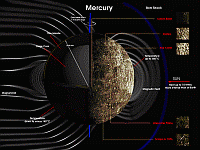
Geology and Magnetosphere of Mercury
[Courtesy: BepiColombo-ESA homepage]
|
|
|
|
|
|
|
|
Magnetic Field: Secret in the Planetary Interior |
|
|
|
|
|
Few information acquired until now shows the singularity of Mercury.
Mercury is known for exceptional high density (5.43 g/cm3).
In terrestrial planets, there is the relationship
between their average radius and density (in right figure),
Mercury separates greatly in a high density side.
This shows the huge core with 70% of the whole mass
and the element composition greatly differerent from other planets.
This fact is considered to be originated in formation of Mercury,
related to the early stage of the solar system.
|
|
|
|
|
|
|
"Existence of a magnetic field" may be related to "high-density."
In the same terrestrial planet, there is no intrinsic magnetic field in Venus.
Mars does not have, too, although the trace of the magnetic field in the old crust
was recently discovered.
The magnetic field is not a natural existence.
Why does the smaller planet Mercury has?
The reason is not solved yet.
In the standard theory, the melted core is needed for the magnetic field.
Is it possible for Mercury?
Magnetic field has a cause in the interior of planet,
and can not be observed by remote sensing methods.
Comparison with the detailed information on the magnetic field and the interior
between Mercury and Earth is required.
|
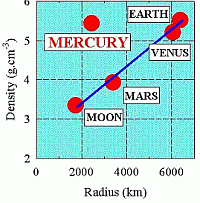
Relationship between Radius and Density of the terrestrial planets
[Courtesy: BepiColombo Study Report]
|
|
|
|
|
|
|
Magnetosphere: Only Planet for the Comparison with Earth |
|
|
|
|
|
Mercury has the smallest Magnetosphere in the known universe.
It is important for the study of the universal process in the Space.
Mariner10 discovered the Magnetosphere, and
observed the explosive high energy electron flow,
which is similar to the one observed in the terrestrial magnetosphere.
However, by the data of the encounters in 30 years ago
the details have not been solved.
The "astronomical magnetospheres" are seen on various scales,
such as planets, the sun and stars, pulsars, and galaxies.
The inquiries of the "universality" in the Mercury magnetosphere of the minimum scale
is important for the study of the terrestrial and astronomical magnetospheres.
|
|
|
|
|
|
|
Mercury does not have sufficient atmosphere,
so that the magnetosphere directly connects to the surface.
In the terrestrial magnetosphere,
the atmosphere (the ionosphere) play the important role
in the electromagtetic processes around the Earth.
Moreover,
the conditions of a solar wind also differ from the earth
because the Mercury is closer to the sun.
What do these differences bring about?
Can such a magnetosphere be stable enough?
What and how energy processes are expected?
There are many arguments but no established stories yet.
The understanding of "peculiarity" of a different magnetosphere like Mercury
leads to a deep understanding of the terrestrial and astronomical magnetospheres
through the elucidation of the role of the environments. |
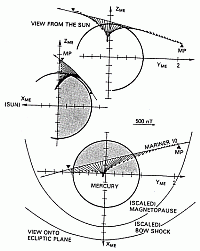
3rd flyby of Mariner 10: Confirmation of
magnetic field & magnetosphere
[Connerney and Ness, 1988]
|
|
|
|
|
|
|
Atmosphere: Letter from the Surface |
|
|
|
|
|
One of the unique elements of Mercury is
the thin sodium atomosphere (Exsophere)
recently discovered with the terrestrial telescope.
This atmosphere is thought to be made from the elements from the surface
by the evaporation heated by sunlight,
or the collision of the solar wind, magnetospheric ions, interplanetary dust, etc.
The "atmosphere" spreads by several times the Mercury radius, and
it is becoming clear to change its quantity and distribution sharply in about one day.
Some scientists descibe that such change is affected by the magnetosphere activity,
but the details are not unknown yet.
|
|
|
|
|
|
|
For the understanding of
structure, composition, and generation/loss processes of the atmosphere,
simultaneous and continuous observations of the stomosphere
with the solar wind and magnetosphere activities is required.
Moreover, the composition of the exosphere
is useful as a unique observation method
which leads to detection of important elements, such as noble gas related to the history of Mercury.
|
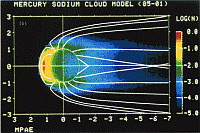
Distribution of Na Atmosphere(model)
[Ip, 1986]
|
|
|
|
|
|
|
Surface & Crust: Unknown History |
|
|
|
|
|
Apparently, Mercury's surface resembles the moon.
However, there are many unique features:
There are only small differences between highlands and seas.
Although volcanic planes are found, there is no traces of volcanos.
There are large-scale geographical features which seems to be related to
cooling process in the early stages of formation.
There is the huge basin (the diameter of 1300km) and
the strange geographical feature located in the opposite side.
|
|
|
|
|
|
|
However, the Mercury surface picturized by Mariner10 is only about 45%,
and the surface composition is not known well.
Moreover, the radar observation from the earth has suggested
some important features such as "the traces of huge volcanos" and "ice at the bottom of the polar craters".
Information of detailed geographical features and composition of all the Mercury surfaces
will lead to the initial formation process of this planet.
|
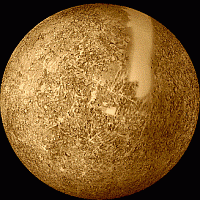
Image taken by Mariner 10
[Courtesy: NASA] |
|
|
|
|
|
|
Mercury Data Room
|
|
|
|
|
|
|
|
|
|
|
|
|
|
|
|

